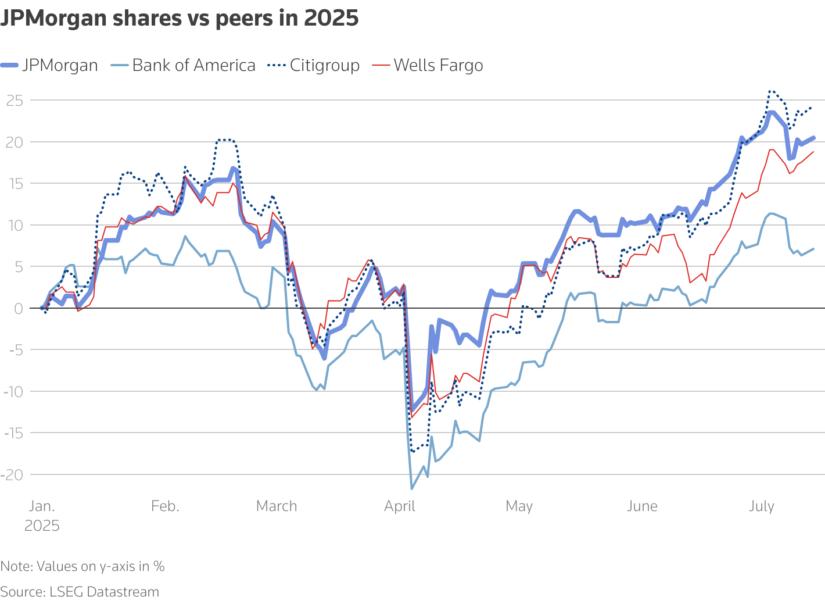JPMorgan profit beats estimates on Wall Street rebound; raises interest income forecast
- JPMorgan raises 2025 net interest income forecast to $95.5 billion
- Trading revenue up 15%, investment banking fees rise 7%
- IPO pipeline improving but concerns remain, CFO says
- Acquisitions have a high bar, CFO says
- Headcount drops by more than 1,300 employees
- Excluding one-off costs, earned $4.96/share vs expected $4.48
JPMorgan Chase JPM raised its net interest income forecast for 2025 after strong results in investment banking and trading helped it surpass profit expectations for the second quarter.
"The U.S. economy remained resilient," CEO Jamie Dimon said. "The finalization of tax reform and potential deregulation are positive for the economic outlook."
Still, he expressed caution about "significant risks" from tariffs and trade uncertainty, worsening geopolitical conditions, high fiscal deficits, and elevated asset prices.
Dimon, 69, who has run the largest U.S. lender for more than 19 years, is one of the most prominent voices on Wall Street. In contrast to rival bank CEOs who have given rosier assessments of the economy, Dimon has been more downbeat and cautious.
The bank now expects about $95.5 billion of NII, or the difference between what it earns on loans and pays on deposits, compared with an earlier estimate of nearly $94.5 billion.
Market activity surged as investors seized opportunities and hedged risks in response to shifting U.S. tariff policies. The turmoil propelled JPMorgan's trading revenue 15% higher to $8.9 billion, driven by gains in both fixed income and equities.
Investment banking fees also rose 7% to $2.5 billion, underpinned by a rise in mergers and acquisitions and debt underwriting.
Both trading and investment banking performed better than management's earlier guidance. While concerns remain, the pipeline for initial public offerings was picking up, CFO Jeremy Barnum said.
A well-capitalized balance sheet helped JPMorgan grow revenue in multiple segments, said Brian Mulberry, senior client portfolio manager at Zacks Investment Management, adding that the higher NII forecast was an "impressive flex."
CONSUMER STRENGTH
Despite worries about tariff-related pressure on households, JPMorgan noted continued signs of consumer resilience.
"The consumer basically seems to be fine," Barnum said. "You see a little bit more stress in the lower income bands. But that's always true. Nothing there is out of line with our expectations."
The bank set aside $2.85 billion in provision for credit losses, compared with $3.05 billion a year earlier.
Excluding one-off costs, the lender earned $4.96 per share, compared with the $4.48 per share that analysts were expecting, according to estimates compiled by LSEG.
Shares were down 0.6%.

POLICY CLOUDS OUTLOOK
Investors are closely scrutinizing banks' results and their executives' commentary this quarter to assess the impact of tariffs and the tax and spending bill signed into law by President Donald Trump this month.
The bill is estimated to add more than $3 trillion to U.S. debt over the next decade, sparking backlash from some Republicans and onetime Trump allies such as Elon Musk, who have raised concerns about fiscal irresponsibility.
However, while uncertainty has clouded the outlook, there were bright spots for lenders during the second quarter. JPMorgan was among 22 large banks that aced the Federal Reserve's stress tests, enabling it to boost its quarterly dividend and announce $50 billion in stock buybacks.
The Fed also advanced a proposal to overhaul the "enhanced supplementary leverage ratio," which could lower the capital large global banks such as JPMorgan must hold against relatively low-risk assets.
INORGANIC GROWTH OPPORTUNITIES
JPMorgan's strong capital base leaves room for mergers and acquisitions, and management once again flagged inorganic growth opportunities, but also warned the bar is high and it is not looking to buy into hot sectors such as private credit or large language models.
"Acquisitions have a high bar, both financially, strategically, and in some cases, culturally," Barnum said. "But we wouldn't be doing our jobs if we weren't thinking about it."
While JPMorgan does not necessarily need M&A in any particular sector to boost growth, the bank could still be on the lookout in areas such as technology.
"If there are areas in the technology side that would further their lead in terms of the efficiency of the business or capabilities that they could offer, from a trading perspective to their corporate clientele, it would be expected that they would pursue those," said Matt Stucky, chief portfolio manager of equities at Northwestern Mutual Wealth Management, which owns JPMorgan stock.
Meanwhile, Dimon said the private credit market may have peaked after its dramatic growth in the last few years.
The CEO, who has been a vocal skeptic of bitcoin, said the bank is going to be involved in stablecoins, without giving details.
Stablecoins, a type of cryptocurrency designed to maintain a constant value, usually pegged to a fiat currency such as the U.S. dollar, are commonly used by crypto traders to move funds between tokens.
Trump has promised to be the "crypto president," popularizing its mainstream use in the U.S.
JPMorgan's headcount fell by more than 1,300 employees to 317,160, but the bank's workforce remains the largest among its peers after a rapid expansion in recent quarters. JPMorgan has said it expects it to be flat in 2025.
Overall profit dropped 17% in the second quarter, but the comparison was skewed because of a nearly $8-billion one-off gain it had recorded on a share exchange agreement with Visa V last year.